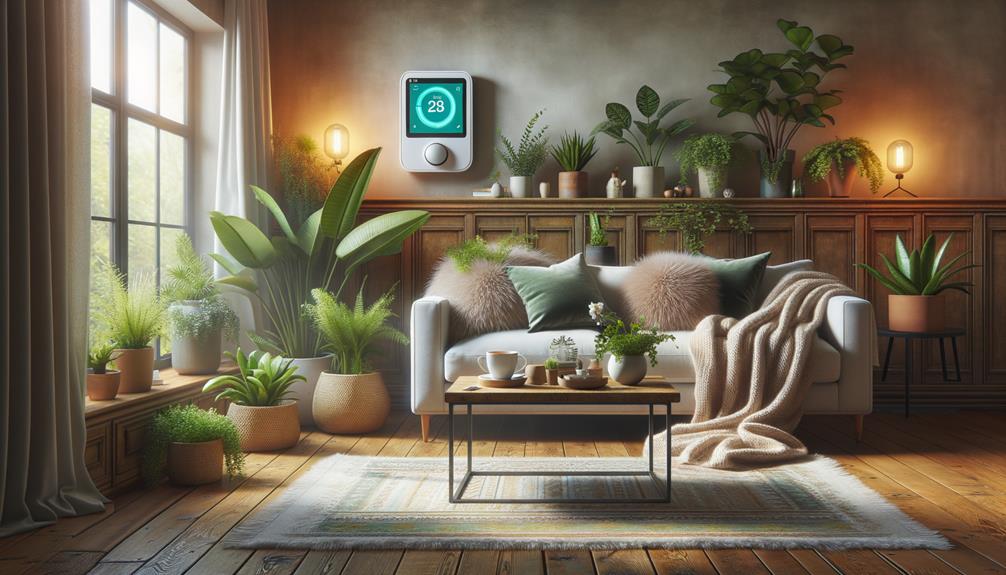Temperature ranges play a crucial role in our health, comfort, and the stability of products. For most adults, a temperature between 18-24°C is considered comfortable, while dropping below that can lead to respiratory issues. In industries like pharmaceuticals, precise temperature control is vital to ensure product integrity, typically between 68-72°F. Smart thermostats can help maintain these ranges effectively. Consistent temperature definitions are also important for compliance with USP-NF and European Pharmacopoeia standards. Despite this, more research is needed to fully understand the impact of different temperatures on our well-being.
Key Takeaways
Ideal room temperatures range from 18-24°C (64-75°F) for healthy adults. Regulatory bodies like USP-NF and European Pharmacopoeia establish specific temperature ranges to ensure product stability. Most people find indoor temperatures between 68-72°F (20-22°C) comfortable. Extreme temperatures can pose health risks, particularly for vulnerable populations. Consistency in room temperature is vital for product integrity and compliance with industry standards.
Room Temperature Standards
Room temperature standards are crucial for ensuring product stability and compliance. Regulatory bodies like USP-NF and European Pharmacopoeia set specific temperature ranges to safeguard product quality and efficacy throughout their shelf life.
The ideal temperature range varies by region. For instance, Indonesia sets a comfort zone between 24-29°C. However, for regulatory purposes, the standards set by USP-NF and European Pharmacopoeia are more precise.
Consistent room temperature definitions are vital for compliance with industry standards and health guidelines. Failing to adhere to these specified ranges can compromise product stability, leading to reduced efficacy or even safety risks. Understanding these temperature specifications is critical for industries that depend on the integrity of their products, whether in pharmaceuticals, food storage, or other sensitive sectors.
Health Implications

Maintaining an ideal room temperature is crucial for our health, particularly for vulnerable populations like infants and the elderly. A comfortable temperature range for healthy adults is between 18-24°C (64-75°F), but for those most vulnerable, a minimum of 20°C (68°F) is necessary to prevent health complications.
When the temperature drops below 18°C (64°F), it can lead to respiratory issues and other health problems, especially during cold seasons. The World Health Organization recommends this minimum temperature to maintain optimal health. On the other hand, extremely high temperatures can also pose health risks, such as heat stress or dehydration, making it essential to manage air conditioning effectively.
A comfortable temperature is not just about physical comfort; it's also about maintaining body heat. Extreme fluctuations or prolonged exposure to unsuitable temperatures can strain the body's ability to regulate heat, leading to various health problems. Striking a balance in indoor temperature is key to ensuring a healthy living environment, especially for those most vulnerable to temperature changes.
Industry Regulations

While personal comfort and health are top priorities, the pharmaceutical industry must also adhere to strict regulations to ensure product quality and stability through controlled room temperatures. Regulations like USP-NF, European Pharmacopoeia, and Japanese Pharmacopeia dictate precise room temperature ranges for storing and stabilizing pharmaceuticals. Meeting these standards is crucial for maintaining product integrity and effectiveness.
Pharmaceutical companies must store products in ideal conditions to prevent degradation and preserve their therapeutic value. Room temperature specifications have a direct impact on storage requirements, making it vital for companies to monitor and control the environment meticulously. Failure to comply can compromise product quality, which is unacceptable in the pharmaceutical industry.
Indoor Climate Control

Ideal indoor climate control is crucial for comfort, health, and energy efficiency. Maintaining a room temperature between 68-72°F significantly enhances indoor comfort. A thermometer helps monitor air temperature accurately, ensuring it aligns with personal preferences and physiological needs. The World Health Organization recommends an indoor temperature range of 64-75°F for optimal health, highlighting the importance of a well-regulated environment.
Body temperature plays a vital role in determining our comfort level indoors. If the room temperature is too high or too low, it disrupts our body's natural regulation processes, leading to discomfort. With a smart thermostat, you can easily maintain the ideal temperature range, adjusting settings based on real-time data and individual needs. This not only promotes better sleep quality but also supports overall well-being.
Smart thermostats also offer an efficient way to balance indoor comfort with energy efficiency. By automatically adjusting the temperature when you're not home, these devices reduce energy consumption and costs. To achieve a comfortable, healthy, and energy-efficient living space, it's essential to master indoor climate control through careful monitoring and smart technology.
Research Insights

Despite the clear benefits of smart thermostats for indoor climate control, there's a surprising lack of high-quality research on how room temperature directly affects our health. Maintaining an ideal body temperature is essential, but the specific impacts of air temperature within a certain range on our well-being remain underexplored.
The World Health Organization (WHO) has called for more research on how high indoor temperatures influence health. They emphasize the need to understand these effects to develop better guidelines. Current recommendations for safe indoor temperature ranges are evolving, but they still rely on incomplete data. This gap in research is problematic, as it leaves many without clear standards for maintaining a healthy indoor environment.
Further studies are necessary to establish definitive guidelines and standards for room temperature maintenance. By understanding how temperature fluctuations impact our health, we could develop more precise recommendations that benefit everyone. A detailed exploration into this research could also reveal critical insights into preventing health issues related to poor indoor climate control. This knowledge is vital for those of us who want to create comfortable and healthy living spaces without compromising our well-being.
Frequently Asked Questions
What Is Ideal Body Temperature by Age?
For adults, the ideal body temperature falls between 97°F and 99°F. For kids, it's slightly higher, ranging from 95.9°F to 99.5°F. Factors like physical activity and the environment you're in can affect these ranges throughout the day.
What Is the Optimal Temperature Range for Humans?
I find that the perfect temperature range for humans lies between 68-72°F (20-22°C). This range fosters comfort, boosts overall well-being, and supports productivity. Any deviation from this range can negatively impact our health and comfort levels.
Is 72 Degrees the Best Temperature?
I believe 72 degrees Fahrenheit is a comfortable temperature that suits most people. It's a balance that promotes relaxation and saves energy. However, personal preferences, humidity, and air circulation can affect how ideal it feels.
What Is the Best Temperature Range?
The ideal temperature range is a sweet spot between 68-72°F. This range offers a perfect balance between comfort and energy efficiency, allowing me to stay cozy and productive without over-relying on the air conditioner.



